If you’re concerned about the climate crisis and what difference your purchasing decisions can make, there’s a really strong argument to prefer jewellery makers who only use recycled precious metals.
- Recycled gold produces up to 99.8% fewer greenhouse gas emissions than mined gold[1];
- Recycling platinum produces about one-twentieth the emissions that mining for platinum does. (That’s a 95% reduction.); and
- Recycling silver produces around 14% of the emissions that silver mining does.
These are huge savings, but what does that mean when it comes to jewellery?
To give you an example, for an average sized, plain wedding band or stacking ring, the numbers look like this[2].
- A ring made with newly mined gold with a carbon cost of up to 64kgs in greenhouse gas emissions might produce as little as 100 grams when made with recycled gold;
- The same ring made using mined platinum would have a carbon cost upwards of 236kgs in greenhouse gases, whereas recycled platinum would only have emitted around 12kgs; and
- A ring made with primary silver that produces around 300 grams of greenhouse gases would have carbon footprint of only 4 grams when made using recycled silver.
These are really encouraging figures. But as it is with just about every other kind of recycling, realising the power of these numbers doesn’t come from the efforts of one or two concerned people. It comes from widespread adoption of ‘recycled’ as the preferred source.
Unfortunately we’re not there yet, but the upside is there’re plenty of room for improvement.
How big is the problem?
In the grand scheme of things, mining precious metals like gold, silver and platinum doesn’t produce anywhere near the quantity of greenhouse gas emissions that minerals like bauxite, iron ore, copper and nickel do. But the numbers are still significant …

When you apply the numbers from row 1 above to the quantity of each of these metals that are mined each year, the emission amounts start to get scary.

(Note, that’s tonnes in Table 2. Nearly 60 million tonnes of greenhouse gas emissions added to the atmosphere every year just from gold mining!)
Gold mining is by far the largest polluter in terms of sheer volume when it comes to precious metals. But if we want to get specific about the impact of the jewellery industry, we need to break the numbers down a bit further.
What part does the jewellery industry play?
The jewellery industry is a big consumer of precious metals, especially of gold and silver. Of all the gold produced in the world each year, approximately 51% goes into jewellery making. 27% of the platinum produced each year goes into jewellery. And around 21% of all silver production goes to jewellery with another 6% going into silverware. (See Table 4 below.)
But of course, not all of the precious metals used in the jewellery industry are freshly dug out of the ground. Recycling already contributes a meaningful amount to the global supply of each (see Table 3 below).
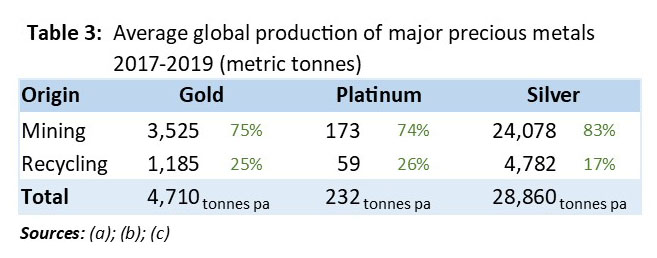
Where does the recycled metal go?
How recycled and primary metals get distributed across different industries is difficult to say. To get some idea, it’s worth taking a look at current demand for these precious metals by industry sector.
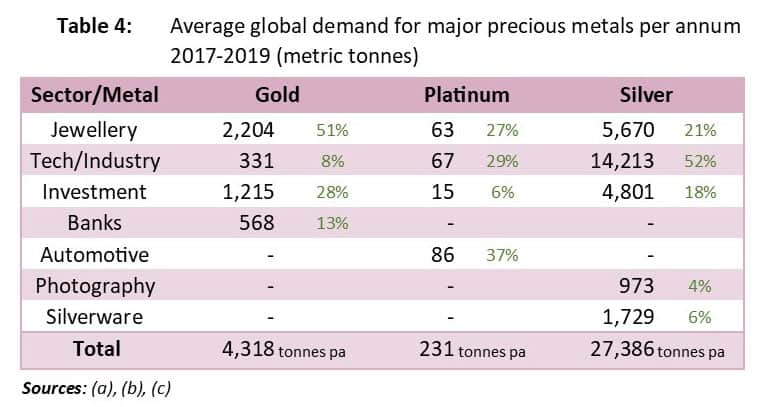
As you can see from Tables 3 & 4 above, even if 100% of the recycled gold, platinum and silver produced each year was devoted exclusively to jewellery production, there would still be a shortfall.
- Gold jewellery manufacturing consumes 51% of the gold produced each year – approximately 2,200 tonnes, but recycling only delivers a little over half that quantity;
- Platinum is a lot closer. Platinum jewellery making consumes around 63 tonnes of total production. Recycling delivers an average 59 tonnes to the market; and
- Manufacturing silver jewellery uses up around 6,000 tonnes of silver each year with recycling only delivering around 4,800 tonnes to the total supply.
But of course, not all recycled precious metals go towards jewellery making. Technology, industrial and finance industry consumers of precious metals are going to purchase from wherever is most convenient and cost-effective.
In other words, there is still plenty of scope for jewellery manufacturers to switch to recycled as their preferred option.
Why does all this matter?
About 15 or so years ago, supporters of recycling argued that if recycled precious metals (especially gold) became the norm for jewellery, that would depress demand for primary metals, thereby reducing the destructive impacts of mining.
In hindsight it’s easy to see why that wasn’t going to happen. Mining of valuable metals like gold makes too big an economic contribution for governments to discourage it. Also, the price keeps trending up, and with it the incentive to dig for more.
So, if mining is going to happen anyway, the question is: Why does it matter where the metal in your jewellery comes from?
It’s a good question. And it all comes back to personal responsibility.
Why do we use our recycling bins when the ‘handful’ of aluminium cans, plastic and glass bottles we send back are a relative drop in the ocean?
We do it because we have that choice and it’s in the best interests of the planet as a whole.
Your decision to throw that plastic bag into a recycling bin and not landfill makes only a tiny difference, but we still know it’s the right thing to do.
With precious metals it’s even more important we recycle them because they’re essentially irreplaceable, they’re extremely rare and, most important of all, they come at a big initial environmental cost.
And, if you really want to get hard-nosed about it, jewellery is not necessary for us to live. Unlike food, shelter and water, it’s a discretionary purchase. That being the case, why would you actively choose a product option that’s known to be very damaging to our environment when there’s a much more environmentally friendly alternative available that is literally identical?
You get to choose
As we’ve already mentioned, a big percentage of the precious metals consumed around the planet each year go into things like investment, technology and industry.
They could turn up in your X-ray images, your mobile phone, in the coins in your pocket or in your new car. But the reality is you have zero say in where the metals that went into those products came from.
With your jewellery it’s different. With your jewellery you get to choose.
You can seek out jewellery made using recycled precious metals. There are plenty of small jewellery companies out there (like our own) dedicated to using only recycled precious metals.
There are larger ones too. For instance, Pandora has committed to switching entirely to using only recycled gold and silver by 2025[3].
Made using some recycled metal is not good enough
Just because a jewellery company says they use recycled metals, don’t assume that all the metal they use is recycled in origin.
Most jewellery makers use at least some recycled precious metals. At the very least they recycle their own scraps and waste. But that’s a far cry from ensuring all of the metal they use to make new pieces comes from a reputable recycler.
Remember the huge difference in the carbon cost between mined precious metals and recycled ones? Using some recycled metal doesn’t cut it when trying to minimise the carbon footprint of a jewellery product. It helps, but given the easy availability of recycled metals and the fact that they’re the same price as the primary product, there’s no reasonable justification for not going 100% recycled.
To put it in context, for the same carbon cost of producing one ring made with primary gold, you could produce up to 630 rings using recycled gold. 630 to 1 … Think about that. Any jewellery business can radically reduce its carbon footprint, at zero cost to them, simply by switching to recycled precious metals. So why don’t they?
Is ‘recycled’ an ethical choice?
This is a question you’ll see almost nowhere else other than in the jewellery industry. And almost always it’s only ever asked in relation to Fair Trade gold.
Fair Trade (or fair mined) gold comes from a small number of certified artisanal mining communities dotted around the world. At this stage they contribute about 1% of global supply annually.
The communities in question benefit from higher prices, safer working conditions and more environmentally friendly processes. All of which are good things.
The pro-Fair Trade gold argument goes along the lines that if gold mining is going to happen anyway – which it is – purchasing anything other than Fair Trade (or fair mined) is unethical. Apparently this is because, by buying recycled, you’re not doing anything to improve the efficiency of the millions of artisanal gold miners in developing nations. Thus, you’re not helping to reduce the overall carbon output of gold mining activities.
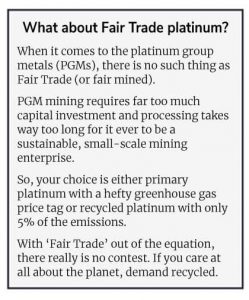 From our perspective we don’t have any issue with the human rights aspect of this argument. Artisanal miners deserve a fairer go. But the problem is artisanal mining is no better than large scale mining when it comes to greenhouse gas emissions. Source: (d)
From our perspective we don’t have any issue with the human rights aspect of this argument. Artisanal miners deserve a fairer go. But the problem is artisanal mining is no better than large scale mining when it comes to greenhouse gas emissions. Source: (d)
By increasing the demand for Fair Trade gold and silver, the most likely outcome is an increase in mining activity simply because it’s more rewarding for the miners who benefit.
In other words, choosing Fair Trade (or fair mined) gold and silver means we’re likely to see even more mining and more damage to the environment. Albeit the trade-off will be better conditions for the miners fortunate enough to be a part of the program. (And perhaps a small reduction in relative emissions for the output of Fair Trade mining derived gold and silver?)
It’s all about what’s ethical to you
Coming full circle, whether you choose recycled or Fair Trade gold or silver becomes a question of how much responsibility you want to take for the generation of greenhouse gases that will wreck our planet if left unchecked. That against how much you want to help a relatively small number of artisanal miners in developing countries?
Is recycled an ethical choice? We say yes.
Is Fair Trade gold and silver an ethical choice? We also say yes, but for very different reasons.
It’s human rights for a few versus reducing your immediate contribution to the climate crisis (which, ultimately, affects everyone). Realistically, that’s the choice that has to be made.
[1] The recycling source is important. Gold recycled from old jewellery, jeweller’s waste and the like achieves a 99.8% reduction in emissions. Recycled gold from E-waste reduces emissions by about 94%. (See Table 1.)
[2] The method for deriving these numbers is detailed later in this article. Note, the figures are for metal production only and exclude the ring manufacturing processes.
[3] In this article, Pandora reveals plans to switch wholly to recycled metal for their silver and gold jewellery.
What’s the carbon cost of a wedding ring?
To try and makes things a bit more real, instead of talking in kilograms, let’s have a look at the differences for something we’re all a bit more familiar with – an ordinary wedding ring.
For simplicity, we’ll work with a plain, half-round, 3mm wide band in a US size 6 (Aust L3/4) – which is a fairly average size.
Of course, rings made with different metals will weigh differently even when they’re exactly the same size and profile because each metal type has a different specific gravity.
Table 5 below shows how the various numbers play out for emissions from a standard sized ring made with different metals coming from different sources.
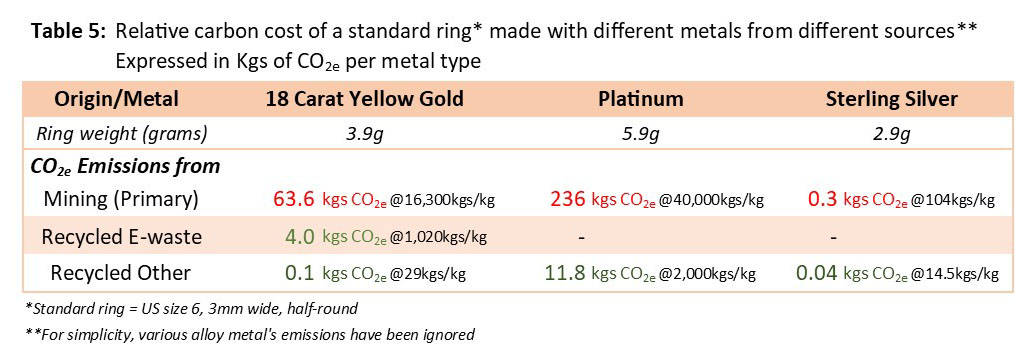
In short, it doesn’t matter which precious metal you prefer, choosing recycled in origin means your jewellery will have a radically smaller carbon footprint than if the metal comes wholly from mining. (This is especially true for gold.)
From a climate change perspective, it really is that simple.
Sources/References:
(a) World Gold Council, 2020. Gold Production Statistics
(b) Johnson Matthey PGM Market Report, 2020
(c) The Silver Institute, Silver Supply & Demand, 2020
(d) Edalmetall Blog, November 2019: Sustainability of Mined vs Recycled Gold
(e) Platinum production GHG emissions: Journal of Industrial Ecology, April 2019
(f) GHG emissions from silver production: A Case Study – Silver Ring Manufacturing, 2015
Ethical Jewellery Australia specialises in creating engagement and wedding rings that are as environmentally and socially responsible as we can make them. Every ring we produce is designed one-on-one with our customers and we would be delighted to help you design yours and make it for you.
Drop us a line at [email protected] if you’d like us to help you create a ring you and your partner will love.
About EJA
Ethical Jewellery Australia is an online engagement, wedding ring and bespoke jewellery specialist. Every piece we do is custom designed and made to order (with the exception of simple wedding and commitment rings that are offered in a range of simple, popular designs).
We take our customers through the whole process from design to sourcing and finally to manufacturing.
All rings are handmade in Australia with recycled metals. (We can also supply Fair Trade gold if requested.)
Likewise, we only every use ethically sourced diamonds and gemstones. You can choose from Argyle, recycled, vintage and lab-grown diamonds, Australian, US, Fair Trade, recycled and lab-grown coloured gemstones.
By the way, we offer an Australia-wide service.
About the Author: Benn Harvey-Walker
 Benn is a Co-founder of Ethical Jewellery Australia and a keen student of ethical and sustainability issues in the jewellery world. He has a long history in sales and marketing and began working with EJA full time in early 2018.
Benn is a Co-founder of Ethical Jewellery Australia and a keen student of ethical and sustainability issues in the jewellery world. He has a long history in sales and marketing and began working with EJA full time in early 2018.
Benn co-authored the original Engagement Ring Design Guide in 2014 and edited the 2nd Edition in 2018. He is also the principal author of our Wedding and Commitment Ring Design Guide.
His main responsibilities at EJA are business development and sales process management. Benn also creates technical drawings for our ring designs.

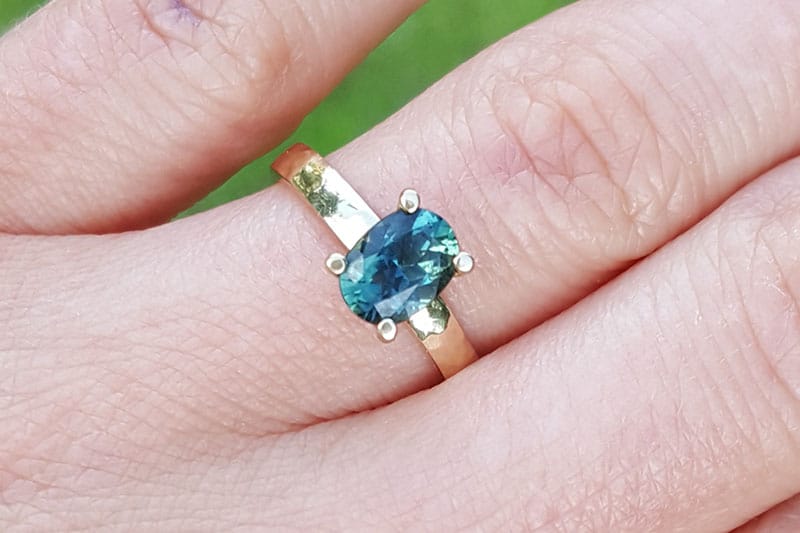
Recent Comments